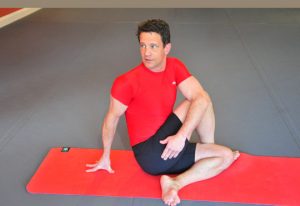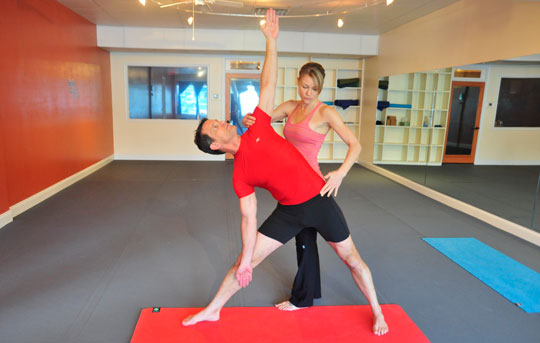No matter where in the body a person feels pain, it’s also in the head. And while drugs — be they natural or manmade — can help control the pain, getting the mind into the body is an even stronger method of pain management, according to Gary Keil.
Keil, a registered pharmacist who also has a doctorate in neuropharmacalogy — the study of how drugs affect cellular function in the nervous system — promotes the ancient Ayurvedic practice of yoga as a means to that end.

His own eye-opening moment came while doing his pharmacy rotation at a veteran’s hospital in Cheyenne, Wyo. There he discovered that 70 percent of all veterans deal with some level of chronic pain.
His original thought was to find ways to develop new medicines, but that changed.
“I asked myself two questions: Do you have to live in pain and what can we do about it,” he said during an interview in the Beautiful Mind Strong Body Center in Kennett Township. Keil and his wife Jenn — who has a degree in kinesiology — recently opened the studio. It’s in the same strip center as the Mendenhall Post Office on Route 52 across from the Mendenhall Inn.
He began thinking about what could be done to improve the situation without drugs. He saw too many cases in which either the wrong drug was given or the dosage was wrong. For him, the mind became the key factor.
“As I got into studying the physical mechanisms of pain, that takes you into the difference between pain and suffering. People can be in pain, but actually not be suffering,” he said.
Keil cited wounded soldiers and women in labor as examples. There are times when a soldier can be in extreme pain, but still function. Some cultures around the world don’t show pain as a major experience in childbirth.
“It shows that how you approach life can dramatically affect the phenomenon we call pain,” he said.
He also learned that how a person thinks of pain influences how a given drug will work, whether the drug is a natural herb or a synthetic pharmaceutical. Keil accepts the concept of a placebo effect in which an inert substance has a desired effect simply because a person thinks it will. But it only works in 30 percent of the cases. He’s also aware of the “nocebo” effect that works in the opposite direction, that people will experience negative side effects because that’s what they believed would happen.
“A person’s impression of what they’re going to experience can override what should be expected…My interest became: Just how powerful can the brain be? It’s probably as effective if not more effective” than the medicine or modality.
Because the mind has such a strong effect on the body, it can be used to eliminate the need for drugs, at least in some cases.
“That’s the goal,” he said. “Here, in the studio, we start with the mind because that’s clearly the place to start.”
How yoga can help with pain management is that it’s a moving meditation, Gary Keil said. That mindfulness and concentration “allows the body to be stimulated in ways that it normally isn’t.”
“What people should know is that if you start twisting your body in certain ways, you start squeezing internal organs in ways you don’t normally. That induces a change in their function and that induces a change in your whole physiology.”
He said the effect is like “wringing out your internal organs,” and calls that a simple and effective way of stimulating the body in physical ways.
But there’s a mental part as well as the physical posture part of the process. People can learn to control their blood pressure and heart rate through the meditative aspects of the practice.
Yoga helps people bring their attention back to their life so they aren’t operating merely on autopilot, as people do about 80 percent of the time, he said.
“That’s an evolutionary adaptation. If your autopilot is a good autopilot, great, but if it’s a destructive autopilot, you’re wreaking havoc. So, the yoga is bringing your awareness back to both your mind and your body and bring that [awareness] to a conscious level.”
It’s that mind-body awareness is what begins the curative process. Keil said the average adult has an estimated 50,000 thoughts per day, with 80 percent being negative. The mind-body connection helps eliminate those. It quiets the internal background chatter.
“It’s only when we’re able to train ourselves to quiet that that we can start hearing other things. That’s when we begin to heal ourselves,” he said.
What’s not resolved through yoga, meditation or other exercises is addressed through journaling and introspection, Keil said.
Both Keils believe that each individual is unique and that there is no single way to address all situations. They set up a specific program for each person, but that evolves over time. They take a case history, medical, physical and emotional and develop the individual program from that information.
As for the physical aspect of what goes on, the studio offers hot yoga, vinyasa or flow yoga, slow flow, barre none, which uses a ballet bar, qi-gong and yogalates, which combines yoga with Pilates.
Studio hours are 6 a.m. to 6 p.m. Monday through Friday an 8-11 a.m. on Saturday. There are also specific workshops offered Saturday afternoons.
Class costs range from $15 per class for walk-ins and $130-$140 for unlimited monthly visits.
Facilities include men’s and women’s showers.
For more information, call 484-770-8599. The studio address is 330 Kennett Pike, suite 107.
Lead photo: Yoga instructor Jenn Keil helps her husband and business partner with a yoga pose.
About Rich Schwartzman
Rich Schwartzman has been reporting on events in the greater Chadds Ford area since September 2001 when he became the founding editor of The Chadds Ford Post. In April 2009 he became managing editor of ChaddsFordLive. He is also an award-winning photographer.



 (6 votes, average: 3.50 out of 5)
(6 votes, average: 3.50 out of 5)
Comments